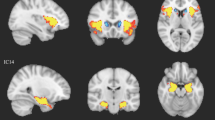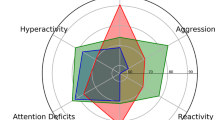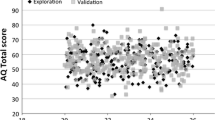Abstract
We tested whether in 85 healthy adults (18–29 years) there is a relationship between grey-matter (GM) volume and autism and ADHD symptom severity. The structural MRI findings and autism and ADHD self-reports revealed that autism and ADHD symptom severity was correlated with GM volume in the left inferior frontal gyrus. Autism symptom-severity was correlated with the left posterior cingulate, ADHD with the right parietal lobe, right temporal frontal cortex, bilateral thalamus, and left hippocampus/amygdala complex. Symptom severity of both disorders form a continuum extending into the general population, but it seems to be an oversimplification to typify psychiatric disorders such as autism and ADHD solely as extremes of brain structure abnormalities.



Similar content being viewed by others
Notes
The results of these three ASD meta-analyses largely converged, but there were differences with respect to whether the left, right or bilateral sections of specific brain areas were deviant. If there were differences between the meta-analyses with respect to the location in either of the hemispheres we did mention a specific hemisphere.
References
Baron Cohen, S. (2001). Theory of mind and autism: A review. In L. M. Glidden (Ed.), International review of research in mental retardation: Autism (Vol. 23, pp. 169–184). San Diego, CA, USA: Academic Press.
Batty, M. J., Liddle, E. B., Pitiot, A., Toro, R., Groom, M. J., Scerif, G., et al. (2010). Cortical gray matter in attention-deficit/hyperactivity disorder: A structural magnetic resonance imaging study. Journal of the American Academy of Child and Adolescent Psychiatry, 49(3), 229–238.
Brieber, S., Neufang, S., Bruning, N., Kamp Becker, I., Remschmidt, H., Herpertz Dahlmann, B., et al. (2007). Structural brain abnormalities in adolescents with autism spectrum disorder and patients with attention deficit/hyperactivity disorder. Journal of Child Psychology and Psychiatry, 48(12), 1251–1258.
Bush, G., Valera, E. M., & Seidman, L. J. (2005). Functional neuroimaging of attention-deficit/hyperactivity disorder: A review and suggested future directions. Biological Psychiatry, 57(11), 1273–1284.
Castellanos, F. X., & Tannock, R. (2002). Neuroscience of attention-deficit/hyperactivity disorder: The search for endophenotypes. Nature Reviews Neuroscience, 3(8), 617–628.
Chabernaud, C., Mennes, M., Kelly, C., Nooner, K., Di Martino, A., Castellanos, F. X., et al. (2012). Dimensional brain–behavior relationships in children with attention-deficit/hyperactivity disorder. Biological Psychiatry, 71(5), 434–442.
Cauda, F., Geda, E., Sacco, K., D’agata, F., Duca, S., Geminiani, G., et al. (2011). Grey matter abnormality in autism spectrum disorder: An activation likelihood estimation meta-analysis study. Journal of Neurology, Neurosurgery and Psychiatry, 82(12), 1304–1313.
Di Martino, A., Ross, K., Uddin, L. Q., Sklar, A. B., Castellanos, F. X., & Milham, M. P. (2009a). Functional brain correlates of social and nonsocial processes in autism spectrum disorders: An activation likelihood estimation meta-analysis. Biological Psychiatry, 65(1), 63–74.
Di Martino, A., Shehzad, A., Kelly, C., Krain Roy, A., Gee, D., Uddin, L., et al. (2009b). Relationship between cingulo-insular functional connectivity and autistic traits in neurotypical adults. American Journal of Psychiatry, 166, 891–899.
Duerden, E. G., Mak-Fan, K. M., Taylor, M. J., & Roberts, S. W. (2012). Regional differences in grey and white matter in children and adults with autism spectrum disorders: An activation likelihood estimate (ALE) meta-analysis. Autism Research, 5(1), 49–66.
Durston, S., & Casey, B. J. (2006). What have we learned about cognitive development from neuroimaging? Neuropsychologia, 44(11), 2149–2157.
Ellison-Wright, I., Ellison-Wright, Z., & Bullmore, E. (2008). Structural brain change in attention deficit hyperactivity disorder identified by meta-analysis. BMC Psychiatry, 8, 51.
Frith, U., Morton, J., & Leslie, A. M. (1991). The cognitive basis of a biological disorder: Autism. Trends in Neurosciences, 14(10), 433–438.
Frodl, T., & Skokauskas, N. (2012). Meta-analysis of structural MRI studies in children and adults with attention deficit hyperactivity disorder indicates medication effects. Acta Psychiatrica Scandinavica, 125, 114–126.
Geurts, H. M., Broeders, M., & Nieuwland, M. S. (2009a). Thinking outside the executive functions box: Theory of mind and pragmatic abilities in attention deficit/hyperactivity disorder. European Journal of Developmental Psychology, 7(1), 135–151.
Geurts, H. M., Corbett, B., & Solomon, M. (2009b). The paradox of cognitive flexibility in autism. Trends in Cognitive Sciences, 13(2), 74–82.
Gitelman, D. R., Ashburner, J., Friston, K. J., Tyler, L. K., & Price, C. J. (2001). Voxel-based morphometry of herpes simplex encephalitis. Neuroimage, 13(4), 623–631.
Good, C. D., Johnsrude, I. S., Ashburner, J., Henson, R. N., Friston, K. J., & Frackowiak, R. S. (2001). A voxel-based morphometric study of ageing in 465 normal adult human brains. Neuroimage, 14(1 Pt 1), 21–36.
Gottesman, I. I., & Gould, T. D. (2003). The endophenotype concept in psychiatry: Etymology and strategic intentions. American Journal of Psychiatry, 160(4), 636–645.
Gray, J. R., Chabris, C. F., & Braver, T. S. (2003). Neural mechanisms of general fluid intelligence. Nature Reviews Neuroscience, 6(3), 316–322.
Happé, F., Ronald, A., & Plomin, R. (2006). Time to give up on a single explanation for autism. Nature Reviews Neuroscience, 9(10), 1218–1220.
Herrmann, M. J., Saathoff, C., Schreppel, T. J., Ehlis, A.-C., Scheuerpflug, P., Pauli, P., et al. (2009). The effect of ADHD symptoms on performance monitoring in a non-clinical population. Psychiatry Research, 169(2), 144–148.
Hoekstra, R. A., Bartels, M., Cath, D. C., & Boomsma, D. I. (2008). Factor structure, reliability and criterion validity of the Autism-Spectrum Quotient (AQ): A study in Dutch population and patient groups. Journal of Autism and Developmental Disorders, 38(8), 1555–1566.
Hyde, K., Samson, F., Evans, E., & Mottron, L. (2009). Neuroanatomical differences in brain areas implicated in perceptual and other core features of autism revealed by cortical thickness analysis and voxel based morphometry. Human Brain Mapping, 31, 556–566.
Kana, R. K., Keller, T. A., Minshew, N. J., & Just, M. A. (2007). Inhibitory control in high-functioning autism: decreased activation and under connectivity in inhibition networks. Biological Psychiatry, 62(3), 198–206.
Kessler, R. C., Adler, L. A., Barkley, R., Biederman, J., Conners, C. K., Faraone, S. V., et al. (2005). Patterns and predictors of attention-deficit/hyperactivity disorder persistence into adulthood: Results from the national comorbidity survey replication. Biological Psychiatry, 57(11), 1442–1451.
Kooij, J. S., Boonstra, A. M., Vermeulen, S. H., Heister, A. G., Burger, H., Buitelaar, J. K., et al. (2008). Response to methylphenidate in adults with ADHD is associated with a polymorphism in SLC6A3 (DAT1). American Journal of Medical Genetics Part B Neuropsychiatric Genetics, 147B(2), 201–208.
Marcus, D. K., & Barry, T. D. (2011). Does attention-deficit/hyperactivity disorder have a dimensional latent structure? A taxometric analysis. Journal of Abnormal Psychology, 120(2), 427–442.
Möller, H.-J. (2009). Development of DSM-V and ICD-11: Tendencies and potential of new classifications in psychiatry at the current state of knowledge. Psychiatry and Clinical Neurosciences, 63(5), 595–612.
Mosconi, M. W., Kay, M., D’Cruz, A. M., Seidenfeld, A., Guter, S., Stanford, L. D., et al. (2009). Impaired inhibitory control is associated with higher-order repetitive behaviors in autism spectrum disorders. Psychological Medicine, 39(9), 1559–1566.
Nakao, T., Radua, J., Rubia, K., & Mataix-Cols, D. (2011). Gray matter volume abnormalities in ADHD: Voxel-based meta-analysis exploring the effects of age and stimulant medication. American Journal of Psychiatry, 168(11), 1154–1163.
Nickl-Jockschat, T., Habel, U., Michel, T. M., Manning, J., Laird, A. R., Fox, P. T., et al. (2012). Brain structure anomalies in autism spectrum disorder—a meta-analysis of VBM studies using anatomic likelihood estimation. Human Brain Mapping, 33(6), 1470–1489.
Reid, R., DuPaul, G. J., Power, T. J., Anastopoulos, A. D., Rogers-Adkinson, D., Noll, M. B., et al. (1998). Assessing culturally different students for attention deficit hyperactivity disorder using behavior rating scales. Journal of Abnormal Child Psychology, 26(3), 187–198.
Rojas, D. C., Peterson, E., Winterrowd, E., Reite, M. L., Rogers, S. J., & Tregellas, J. R. (2006). Regional gray matter volumetric changes in autism associated with social and repetitive behavior symptoms. BMC Psychiatry, 6, 56.
Rommelse, N., Franke, B., Geurts, H., Hartman, C., & Buitelaar, J. (2010). Shared heritability of attention-deficit/hyperactivity disorder and autism spectrum disorder. European Child and Adolescent Psychiatry, 19(3), 281–295.
Rommelse, N. N. J., Geurts, H. M., Franke, B., Buitelaar, J. K., & Hartman, C. A. (2011). A review on cognitive and brain endophenotypes that may be common in autism spectrum disorder and attention-deficit/hyperactivity disorder and facilitate the search for pleiotropic genes. Neuroscience and Biobehavioral Reviews, 35(6), 1363–1396.
Rouw, R., & Scholte, H. S. (2010). Neural basis of individual differences in synesthetic experiences. The Journal of Neuroscience, 30(18), 6205–6213.
Schmitz, N., Rubia, K., Daly, E., Smith, A., Williams, S., & Murphy, D. G. (2006). Neural correlates of executive function in autistic spectrum disorders. Biological Psychiatry, 59(1), 7–16.
Seidman, L. J., Biederman, J., Liang, L., Valera, E. M., Monuteaux, M. C., Brown, A., et al. (2011). Gray matter alterations in adults with attention-deficit/hyperactivity disorder identified by voxel based morphometry. Biological Psychiatry, 69(9), 857–866.
Semrud-Clikeman, M., Pliszka, S. R., Bledsoe, J., & Lancaster, J. (2012). Volumetric MRI differences in treatment naive and chronically treated adolescents with ADHD-combined type. Journal of Attention Disorders. doi:10.1177/1087054712443158.
Smith, S. M. (2002). Fast robust automated brain extraction. Human Brain Mapping, 17(3), 143–155.
Stanfield, A. C., McIntosh, A. M., Spencer, M. D., Philip, R., Gaur, S., & Lawrie, S. M. (2008). Towards a neuroanatomy of autism: A systematic review and meta-analysis of structural magnetic resonance imaging studies. European Psychiatry, 23(4), 289–299.
Stark, R., Bauer, E., Merz, C. J., Zimmermann, M., Reuter, M., Plichta, M. M., et al. (2011). ADHD related behaviors are associated with brain activation in the reward system. Neuropsychologia, 49(3), 426–434.
Taylor, E., Dopfner, M., Sergeant, J., Asherson, P., Banaschewski, T., Buitelaar, J., et al. (2004). European clinical guidelines for hyperkinetic disorder—first upgrade. European Child and Adolescent Psychiatry, 13(Suppl 1), I7–30.
Uterwijk, J. (2000). WAIS-III Nederlandstalige bewerking. Technische handleiding. Lisse: Swets & Zeitlinger.
Via, E., Radua, J., Cardoner, N., Happe, F., & Mataix-Cols, D. (2011). Meta-analysis of gray matter abnormalities in autism spectrum disorder: Should Asperger disorder be subsumed under a broader umbrella of autistic spectrum disorder? Archives of General Psychiatry, 68(4), 409–418.
Viding, E., & Blakemore, S. J. (2007). Endophenotype approach to developmental psychopathology: Implications for autism research. Behavior Genetics, 37(1), 51–60.
Volkmar, F. R., Lord, C., Bailey, A., Schultz, R. T., & Klin, A. (2004). Autism and pervasive developmental disorders. Journal of Child Psychology and Psychiatry, 45(1), 135–170.
von dem Hagen, E. A. H., Nummenmaa, L., Yu, R., Engell, A. D., Ewbank, M. P., & Calder, A. J. (2011). Autism spectrum traits in the typical population predict structure and function in the posterior superior temporal sulcus. Cerebral Cortex, 21(3), 493–500.
Wechsler, D. (2001). WAIS-III Canadian technical manual. Toronto, ON, Canada: The Psychological Corporation.
Zhang, Y., Brady, M., & Smith, S. (2001). Segmentation of brain MR images through a hidden Markov random field model and the expectation-maximization algorithm. IEEE Transactions on Medical Imaging, 20(1), 45–57.
Acknowledgments
We thank Andries van der Leij and Romke Rouw for various fruitful discussions. We thank Sanne van den Bergh for assisting us with the manuscript preparation.
Conflict of interest
None of the authors, Hilde M. Geurts, K. Richard Ridderinkhof, and Steven H. Scholte, reported any biomedical financial interests of other potential conflicts of interest.
Author information
Authors and Affiliations
Corresponding author
Rights and permissions
About this article
Cite this article
Geurts, H.M., Ridderinkhof, K.R. & Scholte, H.S. The Relationship Between Grey-Matter and ASD and ADHD Traits in Typical Adults. J Autism Dev Disord 43, 1630–1641 (2013). https://doi.org/10.1007/s10803-012-1708-4
Published:
Issue Date:
DOI: https://doi.org/10.1007/s10803-012-1708-4




